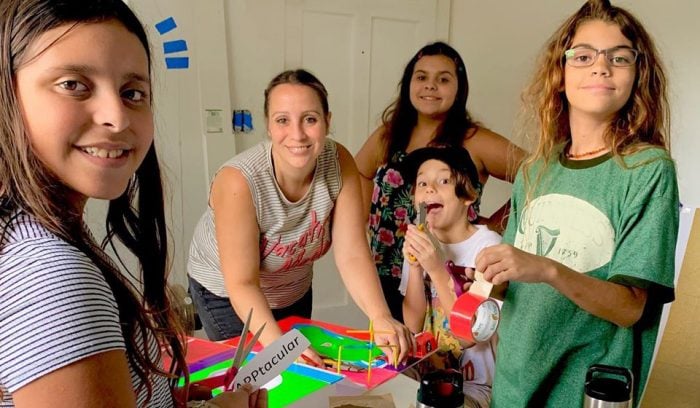Editor’s note: follow this author to be notified when each piece of this mindful homeschooling series is published!
~
“I hear you! Homeschooling my daughters was my choice on my own time!”
Looking back at when I made the decision to homeschool my daughters, what now seems like a lifetime ago, it was not a decision that came easily to me at the slightest.
The original thought came about from my dissatisfaction with the school system, as I witnessed my children drastically change those couple of years they were in school. Their ideals and the way they perceived the world were swapped out for a cookie-cutter response to life inquiries. They became conditioned rather quickly to the world that they would spend most of their days in and had started to forget the innate knowledge they came into the world with.
I held on to the hope of one day homeschooling them, before this change was no longer reversible, but felt it was impossible under the circumstances I had created for myself.
I was a small business owner with long work hours, we lived on a tight income, and my now ex-husband did not embrace the concept of homeschooling at the time. It wasn’t until we started to experience the crumbling of our family structure, as we went through divorce, that those things seemed to no longer matter. My kids’ emotional suffering started to spill into their school day. There just wasn’t enough time away from school to comfort them and to embrace their insecurities. The teachers were kind and catered to their tears sweetly, but I felt really strongly that they needed support from me, time to process, and a lifestyle that would allow them to cope with all the changes.
That’s when I made the choice to homeschool and just hoped I would eventually figure the logistics out.
Was I ready? No.
Was emotionally prepared? No.
Did I feel competent enough to teach them? No.
Did I feel like I had any idea of what the hell I was doing, if they were going to turn out alright, or if they were going to be the product of the biggest mistake of my life? Nope!
Nope. Nope. Nope and Nope!
But it was my choice. And whether I was ready or not, I made it willingly. Because I had a vision of what I wanted our life to be.
And here we are today, with thousands of families choosing to homeschool because they fear for their children’s well-being or the logistics of the new social distancing protocols, thousands of families being forced to school at home because of large number of COVID-19 cases in their communities, and thousands of families just trying to make the part-time schooling—which has been created to keep class sizes small—work for their families. Most of these choices were made from not having many choices at all.
I hear you, Momma! Not having a choice in your child’s education is not ideal.
I hear you, Dad! If you were going to homeschool, it would have been nice for it to come out of your own intent or curiosity for something different.
But even though we are being forced to raise our children in a world full of uncertainty of what life will look like next month, next season, or next year, I am here to tell you:
Your children will be okay!
Whatever you’ve chosen for their education, you made the best choice you could in that moment. And as a mom who has been through it before, here are some things I would like to share to make your experience run smoothly, be more enjoyable, and flow organically.
1. Mindset
Take a moment to step outside of what you are used to, and realize that you are not creating school at home; you are just adapting learning to your life. Everything we go through daily has a lesson within. There is no need to add an engrossing number of tasks for children to learn.
Read more in detail about having the right mindset here.
2. Deschooling
Forget the way it was when you went to school and forget the way it “should” be. There is no right and wrong way. There is just the way that works for your child and the way that does not. Be open to things as simple as sitting on the bed instead of a chair or as drastic as choosing something other than virtual learning.
What you need to know about deschooling.
3. Curriculum
If you are working with a curriculum that has been assigned to you, always remember, you can change your mind at any point of this experience. We have switched from online curriculums to book curriculums to project-based learning repeatedly. There are plenty of ways to learn, and your child learns versatility as you search for the right fit.
“Why didn’t they teach me these things in school?”—how to design a curriculum.
4. Schedule
The schedule should revolve around the parent, and there is no need to fill your day with an excessive number of activities. Kids don’t need eight hours of schoolwork a day—one to three hours, depending on their age, is plenty.
This Anti-Meltdown Homeschooling Schedule will save your Sanity.
5. Family Contract
Even though learning will be done at home, you are not your child’s teacher, you are a facilitator of their learning, and it will be helpful to create a set of rules or agreements within which to coexist. It’s important to create clear boundaries, setting time in which each individual can just be, relax, and decompress, but also goals that will need to be accomplished each day or week.
Family Dysfunction: Understanding Fear-Based Respect vs. Mutual Respect.
6. Socialization
Creating relationships does not only refer to meeting new people; it’s also about nurturing the social aspect of the home—how each member relates to each other, how they respect their differences, and how they share space. This will create the groundwork for building relationships outside the home.
For our Bored & Lonely Kids while in Lockdown.
7. Support System
It takes a village to raise a child, and it’s important to choose your village properly. When I started my journey, I reached out to many mommas that had been through it before, and now I give back by doing the same for other moms. This village can help with moments of uncertainty but also for playdates and socialization.
What to do when Absolutely Nobody Supports your Choice to Homeschool.









Read 8 comments and reply